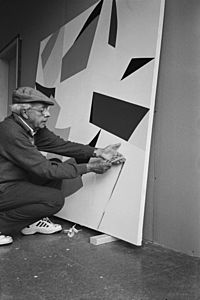Marcel Barbeau facts for kids
Quick facts for kids
Marcel Barbeau
|
|
|---|---|

Marcel Barbeau at his atelier in Estrie, Sutton, Quebec in 2001
|
|
| Born |
Christian Marcel Barbeau
February 18, 1925 |
| Died | January 2, 2016 (aged 90) Montreal, Quebec, Canada
|
| Known for | Multidisiplinary Artist |
| Spouse(s) | Suzanne Melouche (m. 1948); Ninon Gauthier (m. 1975) |
Marcel Barbeau, OC OQ RCA (February 18, 1925 – January 2, 2016) was a famous Canadian artist. He was a painter, sculptor, and graphic artist. He also created performance art. Marcel Barbeau used many different art styles and techniques. He often explored abstract art, which doesn't show real-life objects.
Contents
Marcel Barbeau's Art Career
Marcel Barbeau was born in Montreal. He studied art at the Ecole du Meuble, an art school in Montreal. His teacher was Paul-Émile Borduas, a well-known artist. Marcel also shared a studio with his classmate, Jean-Paul Riopelle.
At the art school, Barbeau became friends with other students of Borduas. They formed a group called the Automatistes. This group was interested in expressing ideas from their minds, even unconscious ones. This way of thinking influenced Marcel Barbeau's art for many years.
In 1948, Marcel Barbeau and the other Automatistes signed something called the Refus Global. This was a statement. It showed they wanted to be free from old, strict art rules. They wanted to create art in new ways.
Exploring New Art Styles
After some of his friends moved away, Marcel Barbeau started to explore his own abstract art. In 1952, he showed small, non-objective paintings in New York City. He also exhibited his work in Canadian cities like Montreal and Ottawa.
Later, he started drawing from live models again. He also experimented with calligraphy, which is a beautiful way of writing. From 1959 to 1961, drawing and collage became his main focus. Collages are artworks made by gluing different materials together.
From 1964 to 1968, he researched Op art. Op Art is a style that uses optical illusions to trick your eyes. He also looked into film techniques. Marcel Barbeau lived in Paris for two years, then moved to New York City. He continued to show his art in both cities. In 1969, two art galleries held a special show of his work. This type of show is called a retrospective. It looks back at an artist's whole career.
A Multidisciplinary Artist
Marcel Barbeau was a true multidisciplinary artist. This means he worked in many different art forms. He wanted to push the boundaries of art.
- His collages sometimes became paintings or sculptures.
- His drawings, made of words and letters, sometimes looked like paintings.
- His sculptures could look like drawings floating in space.
- He also created performances. These were like live art shows. He would create paintings or drawings during these shows. Photographers and filmmakers would record them. This made the art last longer than the performance itself.
Marcel Barbeau was always curious. He studied other art forms like poetry, music, dance, and architecture. He used ideas from these to make his own art fresh and new. For example, his "phonic calligraphies" were inspired by his friend's poetry. He even created dance performances for his art exhibits.
Even though he worked in many different ways, his art had a strong unity. He always aimed for simple, perfect art.
Public Collections
Marcel Barbeau's art can be found in over 50 public and company art collections. Some of these include:
- The National Gallery of Canada
- The Art Gallery of Ontario
- The Stedelijk Museum in Amsterdam
Honours and Awards
Marcel Barbeau received many awards and honours for his art:
- 1972: Canada Council’s Victor Martyn Lynch-Staunton Award
- 1995: He became an Officer of the Order of Canada. This is a high honour for Canadians.
- 1998: One of his artworks was used on a stamp by Canada Post. It was part of a collection about the Automatistes artists.
- 2003: He became a member of the Royal Canadian Academy of Arts.
- 2013: He won a Governor General's Awards in Visual and Media Arts.
- 2013: He received the Paul-Émile Borduas Award, a top prize in Quebec.
- 2015: He was given the Ordre National of Québec.
Legacy
Marcel Barbeau's artistic records are kept in archives. These include the Archives de l’UQAM in Montreal and the Archives nationale du Québec in Quebec City. These records help people study his life and art for years to come.

